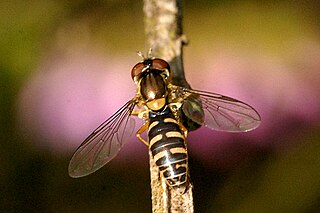
Hoverflies, also called flower flies or syrphids, make up the insect family Syrphidae. As their common name suggests, they are often seen hovering or nectaring at flowers; the adults of many species feed mainly on nectar and pollen, while the larvae (maggots) eat a wide range of foods. In some species, the larvae are saprotrophs, eating decaying plant and animal matter in the soil or in ponds and streams. In other species, the larvae are insectivores, preying on aphids, thrips, and other plant-sucking insects.

Eristalis is a large genus of hoverflies, family Syrphidae, in the order Diptera. Several species are known as drone flies because they bear a resemblance to honeybee drones.

Platycheirus clypeatus is a species of hoverfly. It is found across the Palearctic and in the Nearctic. The larvae feed on aphids. Adults are usually found on the edges of woodland or scrub, heath or along hedgerows where they visit a wide range of flowers.

Dasysyrphus is a genus of hover flies with 50 identified species distributed worldwide. While the genus is relatively easy to identify, the differences between species have a more narrow range of variations. Therefore, identification of species by images of specimens alone should be made with care.

Sphaerophoria is a genus of hoverflies. Species slender 5.6-12mm long with extremely large hemispherical male terminalia after which the common name globetail has been created. There are bright yellow markings on head and thorax and usually on the abdomen but some species have a black abdomen. They can be found worldwide but are common in North America, Europe, Asia and Australia. There are over 73 described species.

Sphaerophoria fatarum is a European species of hoverfly.
In the 10th edition of Systema Naturae, Carl Linnaeus classified the arthropods, including insects, arachnids and crustaceans, among his class "Insecta". Insects with simply two wings were brought together under the name Diptera.

The Brachyopini is a tribe of hoverflies. Unlike many members of this family these flies are generally darker and less colourful though some genera contain species with an attractive metallic lustre e.g. Chrysogaster. Some like Brachyopa are associated with sap runs where their larvae feed on decaying sap. Others are found in boggy areas where their often semiaquatic larvae feed on decaying organic matter.

Eristalini is a tribe of hoverflies. Several species are well-known honeybee mimics, such as the drone fly Eristalis tenax, while other genera such as Helophilus and Parhelophilus exhibit wasp-like patterns of yellow and black stripes, both strategies to avoid predation by visual predators such as birds.

The Syrphini are a tribe of hoverflies.
Platycheirus europaeus is a Palearctic species of hoverfly. It is found in many parts of Europe and eastern Asiatic Russia The habitat is brook floodplains and wet flushes in montane grassland and beside streams or flushes in forest in the Carpinus and Quercus zone up into the Fagus and Picea/ Pinus zone. Flies among grasses from May to August. Flowers visited include Graminae and Cyperaceae, Ranunculus, Taraxacum.
Platycheirus melanopsis is a species of hoverfly. It is found from northern Europe across to eastern Siberia. The larva is described by Rotheray
Platycheirus ramsaerensis is a Palearctic species of hoverfly. It is found along the parts of northern Europe that face the Atlantic. It is a member of the Platycheirus clypeatus group
Dasysyrphus pauxillus is a North American and European species of hoverfly.
Sphaerophoria bankowskae is a European species of hoverfly.
Eupeodes nielseni is a Palearctic hoverfly.
Total of 245 species either found or highly expected to be found in New York.










